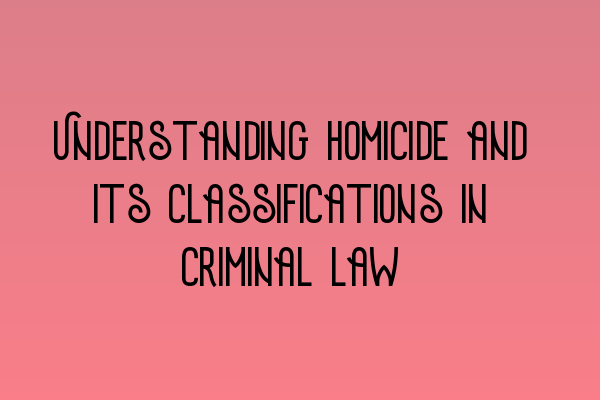Understanding Homicide and Its Classifications in Criminal Law
As criminal law practitioners, it is essential to have a comprehensive understanding of the different classifications of homicide. Homicide refers to the act of one person causing the death of another, and it is one of the most serious crimes in our legal system. By understanding these classifications, we can navigate the intricacies of homicide cases and provide effective legal representation to our clients.
In criminal law, homicide can be broadly categorized into two main classifications: murder and manslaughter. Let’s delve into each of these classifications to gain a better understanding.
Murder is the most severe form of unlawful killing and is divided into two categories: first-degree murder and second-degree murder. First-degree murder involves intentional killings that are premeditated and carried out with malice aforethought. It typically involves a strong intent to cause the death of the victim.
On the other hand, second-degree murder is characterized by intentional killings without premeditation. It often occurs in the heat of the moment, without the specific intent to kill. However, the act of the defendant is usually highly reckless or with extreme disregard for human life. It is crucial to distinguish between the two degrees of murder as they carry different penalties and require distinct legal strategies.
Manslaughter, unlike murder, does not involve the element of malice aforethought. It refers to the unlawful killing of another person without the intent to cause death. Manslaughter can be further divided into two main subcategories: voluntary manslaughter and involuntary manslaughter.
Voluntary manslaughter occurs when an individual intentionally causes the death of another person but does so under circumstances that mitigate the culpability. These circumstances often include a sudden and adequate provocation. It is essential to establish these mitigating factors to potentially reduce the severity of the charges.
Involuntary manslaughter, on the other hand, refers to unintentional killings resulting from reckless or criminally negligent behavior. This can occur when an individual acts with a disregard for the safety of others and causes an unintended death. Involuntary manslaughter is a complex classification, and various factors need to be considered when building a defense strategy.
It is important to note that the classifications and their definitions may vary slightly depending on the jurisdiction. Therefore, it is imperative to familiarize yourself with the specific laws and regulations relevant to your jurisdiction.
As criminal law practitioners, our role is to ensure justice is served and to protect the rights of our clients. Understanding the different classifications of homicide enables us to provide the best legal representation and build strong defense strategies. The complexity of these cases requires a deep understanding of the legal framework and knowledge of the precedents set in previous cases.
To enhance your understanding of criminal law, including homicide classifications, we recommend exploring our SQE 1 Practice Exam Questions and SQE 1 Practice Mocks FLK1 FLK2. These resources will help you gain a deeper insight into the practical application of legal principles.
For those aspiring to become criminal law practitioners, our SQE 2 Preparation Courses and SQE 1 Preparation Courses are designed to provide comprehensive knowledge and skills necessary for the SQE exams. These courses cover a wide range of topics, including criminal law, to ensure you are fully prepared and confident in your abilities.
Stay updated with the latest developments in SQE exams and important dates by referring to SRA SQE Exam Dates. These dates are crucial as they determine when exams are held, registration deadlines, and other essential information.
In conclusion, understanding the classifications of homicide is crucial for criminal law practitioners. By familiarizing ourselves with the distinctions between murder and manslaughter, as well as their subcategories, we can effectively represent our clients and uphold justice. Keep expanding your knowledge with the related articles mentioned above and stay at the forefront of criminal law practice in the UK.
